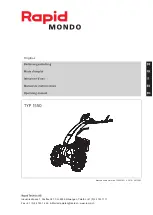
Copyright © 2000 Rayco - All Rights Reserved
Printed in U.S.A.
RG 1635A STUMP CUTTER
RAYCO
®
10
5. Do not smoke in areas where batteries are
charged. When using jumper cables always
connect positive (+) cable, to positive (+)
terminal of battery (the terminal that is
connected to starter solenoid), and negative (-)
cable from external source, to ground. Make
last connection and first disconnection at a
point away from battery. Always connect
negative (-) cable last, and disconnect it first.
See the 'Operation' section of the manual for
specific instructions.
6. Clean and tighten all electrical connections.
Check daily for loose or frayed electrical wires.
Have all loose or frayed electrical wires
tightened, repaired or replaced before operating
the machine. Never allow a live electrical wire
make contact with your body or with any metal
that is touching your body.
7. Have a fire extinguisher available and know
how to use it. Inspect and have it serviced as
recommended on its instruction plate.
Oils
Hot oils and components can cause personal burns.
Do not allow hot oil or components to contact the skin.
At operating temperature, the hydraulic tank is hot.
Relieve all pressure in hydraulic system before any
lines, fittings, or components are loosened or
disconnected.
Battery Acid
Always wear protective clothing and eyeglasses when
working with battery.
For further important battery safety information, con-
sult the
Wisconsin [Engine] Operation Manual
.
Lines, Tubes, and Hoses
Do not bend or strike high pressure lines. Do not install
bent or damaged lines, tubes, or hoses.
Repair any loose or damaged fuel and oil lines, tubes,
and hoses. Leaks can cause fires. Contact
RAYCO
®
or your
RAYCO
®
dealer for repair or replacement.
Check lines, tubes, and hoses carefully. Do not use
your bare hand to check for leaks. See '
General
Hazard Information
- Fluid Penetration' in this
'
Safety
' section for more details. Tighten all
connections sufficiently.
Replace if any of the following conditions are
found:
1. End fittings damaged or leaking
2. Outer covering chafed or cut, and fabric or wire
reinforcing exposed.
3. Outer covering ballooning locally.
4. Evidence of kinking or crushing of the flexible
part of the hose.
5. End fittings displaced.
Make sure that all clamps, guards, and heat shields
are installed correctly to prevent vibration, rubbing
against other parts and against excessive heat, dur-
ing operation.
Before Starting the Engine
1. Review all of the safety decals that are placed
on the machine for your safety and conve-
nience. See '
Parts
' section for aid in locating
all decals on machine.
2. Make sure that all shields, guards and curtains
are in place, and in good condition prior to
operating the machine.
3. Only responsible, properly instructed individuals
should operate this machine. Inexperienced
operators must always be carefully supervised.
4. Check cutting wheel for damaged or missing
teeth, and replace as necessary.
5. Make sure that no one is working on, under-
neath or close to the machine before starting
the engine or beginning to move the machine.
Make sure that the area is free of personnel.
6. Check stumps to be removed for embedded
nails, wire, metal fence posts, and other
metallic objects, and for rocks or other buried
impediments which may become dangerously
thrown or cause unexpected machine move-
ments when hit by cutting wheel.
S
AFETY











































